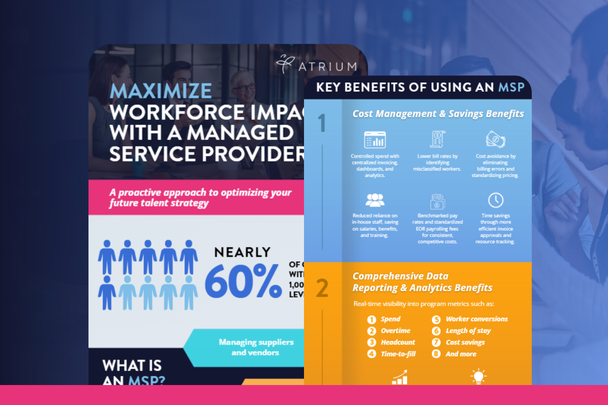Recapping the 2025 CWS Summit North America
Contingent talent is increasingly becoming a powerful force behind innovation, growth, and overall business performance. Earlier this month, our team of experts joined other workforce leaders from across the country at the 2025 SIA CWS Summit North America to explore what’s next in technology, program strategy, operations, compliance, and talent management.
As proud event sponsors with over three decades of experience guiding organizations on workforce strategy, we led conversations that reinforced a key theme: programs succeed when they are agile, collaborative, and closely aligned with business goals. Here are five takeaways from the event that are shaping the future of contingent workforce programs:
1. MSPs are Strategic Partners, Not Vendors
Expectations for Managed Service Providers (MSPs) are evolving. Talent quality remains critical, but companies now prioritize data insights, innovation, and technology enablement.
Key expectations of MSPs today include:
-
- Connecting talent strategy to business goals
- Providing access to multiple talent channels for reach and flexibility
- Optimizing high-performing supply chains
- Delivering actionable insights, not static reports
- Advising on long-term workforce strategies.
When organizations treat MSPs as strategic partners, rather than transactional vendors, workforce programs become a key component of business growth. This goes beyond filling roles quickly at a low cost. It includes providing managers with real-time data, guiding hiring strategies, and building talent pipelines. Effective MSPs also act as an extension of TA and HR, enabling companies to respond to current talent demands while preparing for long-term workforce needs.
2. Building Strength Through a Blended Workforce
Are you combining full-time employees (FTEs) with contingent talent effectively? Organizations are upskilling FTEs while leveraging contingent workers for specialized skills and knowledge transfer. This combination helps maintain long-term value, even as contingent workers transition from your company.
With Artificial Intelligence (AI) reshaping roles across all levels, the mix of FTEs and contingent talent will continue to evolve. Companies that view this balance as a long-term strategy, rather than a short-term fix, are in the best position for success.
3. Global Programs with Local Precision
With most contingent spend concentrated in the U.S., Japan, and EMEA, a one-size-fits-all global strategy often falls short. Flexible, locally adapted multi-national approaches deliver better results.
Strong global programs include:
- Steering committees spanning HR, Procurement, Finance, and Legal
- Country-specific complexity heatmaps and funding models
- Local control towers to oversee external contracting
- Partner networks for cultural and operational fit
- Budgets tied to spend, not headcount
- VMS/MSP reporting that challenges default contracting choices
Without a country-by-country risk view, organizations can face unexpected challenges when expanding globally. Understanding local nuances and potential risk areas gives leaders the insight to make informed decisions about the best approach in each market, supporting sustainable growth and stronger workforce outcomes.
4. Leverage Technology, AI, and Data Strategically
AI is already embedded in most extended workforce programs, from the automation of redundant tasks to the enhancement of complex work with AI-driven insights. However, the goal is to rethink how work is managed rather than simply automate existing processes.
Technology is what determines whether programs succeed or struggle. Start by implementing the right tech stack and then apply AI and Robotic Process Automation (RPA) to eliminate risk and accelerate decision-making. Adopt AI only where it addresses a clear challenge and fits your risk profile, and integrate talent tech stacks across FTEs, contingent, and mobility programs to reduce fragmentation and maximize value. Otherwise, you’re just automating chaos.
5. Turning Strategy into Action Through Adoption
Even the most innovative processes, advanced technology, and future-ready contracts mean little without adoption. Real progress happens when these elements are fully integrated into daily operations and embraced across the organization.
Successful programs rely on champions and advocates; leaders who drive engagement, model new behaviors, and connect program outcomes directly to business goals. Adoption is the strategy that turns plans into performance and vision into measurable business impact.
A Future-Ready Workforce Strategy
Contingent labor is becoming a strategic cornerstone for many leading organizations, aligned with corporate roadmaps and shareholder value. Companies that master the four key elements laid out above, including strategic partnerships that extend capabilities, flexibility to pivot in changing markets, global talent access, and smart technology integration, will thrive. But simply having these pieces isn’t enough. Success depends on how effectively companies integrate these elements and drive adoption throughout the business.
Are you ready to advance your strategy? With over 30 years of expertise in workforce management, Atrium is here to guide you every step of the way. Contact us today with any questions about building a successful program.











